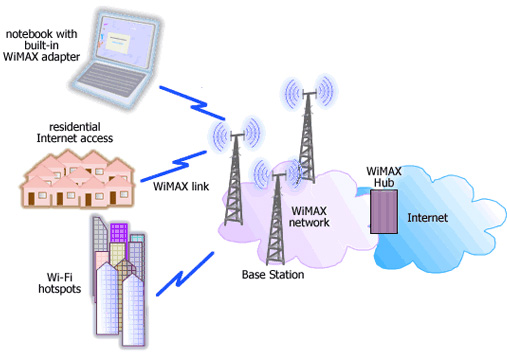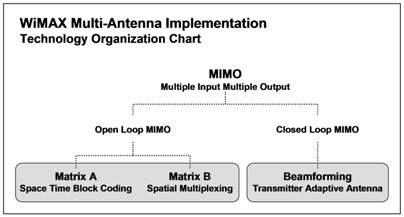WiMax - P.1: WiMax overview
WiMax - WiMax is a standard of the Electrical and Electronic Architecture Institute (IEEE) with the 802.16 design pattern.
As we all know, 802 (part of 802.16) means that this standard is implemented by the LAN / MAN committee that designed the 802.16 model (in 802.16) which means that this standard has been developed / adopted. by Broadband group Wireless Access Working of the LAN / MAN subcommittee.
History of WiMax
The idea of WiMax began in the mid-1990s. At that time, the high-tech industry was making significant progress, and this was also the time of the explosion of new ideas. Telecommunications service providers have recognized the huge demand of Internet access using bandwidth. This need arises from individual users and business users. Many media companies began to plan and design distribution networks that could handle large traffic. In most cases, these networks are called fiber optic networks.
The need to use fiber optic cable to provide broadband Internet access is very high. Estimated, the price of this cable is about 300USD / foot (0.3048m). Therefore the cost to deploy this type of network will be very expensive. As this type of network is gradually improving, some companies have conducted research on another type that can provide broadband Internet access at reasonable prices. The solution they choose is to use WiFi technology.
Intel has always been the leader in WiFi bandwidth access. Intel has been researching WiFi development since the early days, even after that they integrated WiFi into the Centrino processor line. Since Intel has experience of WiFi access, they hope to be able to develop a new type of WiFi access.
Of course, Intel also encountered some difficulties. First, in the North American market, many service providers have deployed fiber-optic networks to provide broadband Internet access so there are many opinions that bandwidth-only Internet access is available. for emerging markets. Second, some service providers have started using their own WiFi bandwidth solutions.
In the early days of development, there were many technologies used in combination with each other and did not follow any standards. Because of non-standard compliance, many users were hesitant to use required hardware because of concerns that it would depend entirely on a certain service provider. Or worse, that technology is not universal and will collapse quickly. This worry of users is very reasonable, the typical case is the failure of VHS / Beta. Therefore, with the hesitation of users when buying the required hardware devices, many hardware vendors also do not take the risk of producing these devices. Intel recognized the problem of not following a standard and tried to convince other vendors. As we have seen, devices or applications of the same type are always developed according to a common standard.
In 2001, IEEE released the 802.16 standard for bandwidth WiFi access. Soon WiMax forum was established to develop this standard, and the term WiMax was formed.
WiMax
The first feature to mention in WiMax is security. As we know, WiFi connection exists a lot of problems, especially when accessing the Internet at public access points. For those who have ever used WiFi, there is no reason why they think similar incidents will not happen to WiMax. In addition, most WiFi security issues stem from the fact that users are also network administrators, and often they are not experienced network security people. WiMax is not within the user's control, it is a solution of the telecommunications service provider. This means that this service provider will conduct network management and experienced network security personnel will secure the network.

Concerning the decline in performance that many users encounter, this is not a problem with WiMax. First of all, this problem has been thoroughly overcome in WiMax with MIMO (multiple-input and multiple-output - multiple inputs and lots of oil output). Similar MIMO has been integrated in WiMax standard.

Another point of WiMax that limits the decline of performance (speed degradation as well as noise) is WiMax using spectrum. This means WiMax uses high cost frequencies. Therefore, microwave or wireless phones will not be subject to interference with WiMax connections and service providers can allocate appropriate broadband for each user to minimize speed decline.
Conclude
In this section, we've outlined some basic information about WiMax, including concepts, development history and some advantages of WiMax. In the next section, we will learn about a rival of WiMax, LTE (Long Term Evolution - the 4th generation mobile bandwidth standard after UMTS - 3G mobile phone technology).
As we all know, 802 (part of 802.16) means that this standard is implemented by the LAN / MAN committee that designed the 802.16 model (in 802.16) which means that this standard has been developed / adopted. by Broadband group Wireless Access Working of the LAN / MAN subcommittee.
History of WiMax
The idea of WiMax began in the mid-1990s. At that time, the high-tech industry was making significant progress, and this was also the time of the explosion of new ideas. Telecommunications service providers have recognized the huge demand of Internet access using bandwidth. This need arises from individual users and business users. Many media companies began to plan and design distribution networks that could handle large traffic. In most cases, these networks are called fiber optic networks.
The need to use fiber optic cable to provide broadband Internet access is very high. Estimated, the price of this cable is about 300USD / foot (0.3048m). Therefore the cost to deploy this type of network will be very expensive. As this type of network is gradually improving, some companies have conducted research on another type that can provide broadband Internet access at reasonable prices. The solution they choose is to use WiFi technology.
Intel has always been the leader in WiFi bandwidth access. Intel has been researching WiFi development since the early days, even after that they integrated WiFi into the Centrino processor line. Since Intel has experience of WiFi access, they hope to be able to develop a new type of WiFi access.
Of course, Intel also encountered some difficulties. First, in the North American market, many service providers have deployed fiber-optic networks to provide broadband Internet access so there are many opinions that bandwidth-only Internet access is available. for emerging markets. Second, some service providers have started using their own WiFi bandwidth solutions.
In the early days of development, there were many technologies used in combination with each other and did not follow any standards. Because of non-standard compliance, many users were hesitant to use required hardware because of concerns that it would depend entirely on a certain service provider. Or worse, that technology is not universal and will collapse quickly. This worry of users is very reasonable, the typical case is the failure of VHS / Beta. Therefore, with the hesitation of users when buying the required hardware devices, many hardware vendors also do not take the risk of producing these devices. Intel recognized the problem of not following a standard and tried to convince other vendors. As we have seen, devices or applications of the same type are always developed according to a common standard.
In 2001, IEEE released the 802.16 standard for bandwidth WiFi access. Soon WiMax forum was established to develop this standard, and the term WiMax was formed.
WiMax
The first feature to mention in WiMax is security. As we know, WiFi connection exists a lot of problems, especially when accessing the Internet at public access points. For those who have ever used WiFi, there is no reason why they think similar incidents will not happen to WiMax. In addition, most WiFi security issues stem from the fact that users are also network administrators, and often they are not experienced network security people. WiMax is not within the user's control, it is a solution of the telecommunications service provider. This means that this service provider will conduct network management and experienced network security personnel will secure the network.

Concerning the decline in performance that many users encounter, this is not a problem with WiMax. First of all, this problem has been thoroughly overcome in WiMax with MIMO (multiple-input and multiple-output - multiple inputs and lots of oil output). Similar MIMO has been integrated in WiMax standard.

Another point of WiMax that limits the decline of performance (speed degradation as well as noise) is WiMax using spectrum. This means WiMax uses high cost frequencies. Therefore, microwave or wireless phones will not be subject to interference with WiMax connections and service providers can allocate appropriate broadband for each user to minimize speed decline.
Conclude
In this section, we've outlined some basic information about WiMax, including concepts, development history and some advantages of WiMax. In the next section, we will learn about a rival of WiMax, LTE (Long Term Evolution - the 4th generation mobile bandwidth standard after UMTS - 3G mobile phone technology).
5 ★ | 1 Vote
 Execute and troubleshoot certificate deployment in ISA Server 2006
Execute and troubleshoot certificate deployment in ISA Server 2006 Remote connection management with mRemote Connection Manager
Remote connection management with mRemote Connection Manager WiFi will reach 1Gbps speed in 2012
WiFi will reach 1Gbps speed in 2012 Execute and troubleshoot certificate deployment issues in ISA Server 2006 - Part 2
Execute and troubleshoot certificate deployment issues in ISA Server 2006 - Part 2 Routing and filtering network traffic - Part 1
Routing and filtering network traffic - Part 1 Routing and filtering network traffic - Part 2: Windows Firewall
Routing and filtering network traffic - Part 2: Windows Firewall